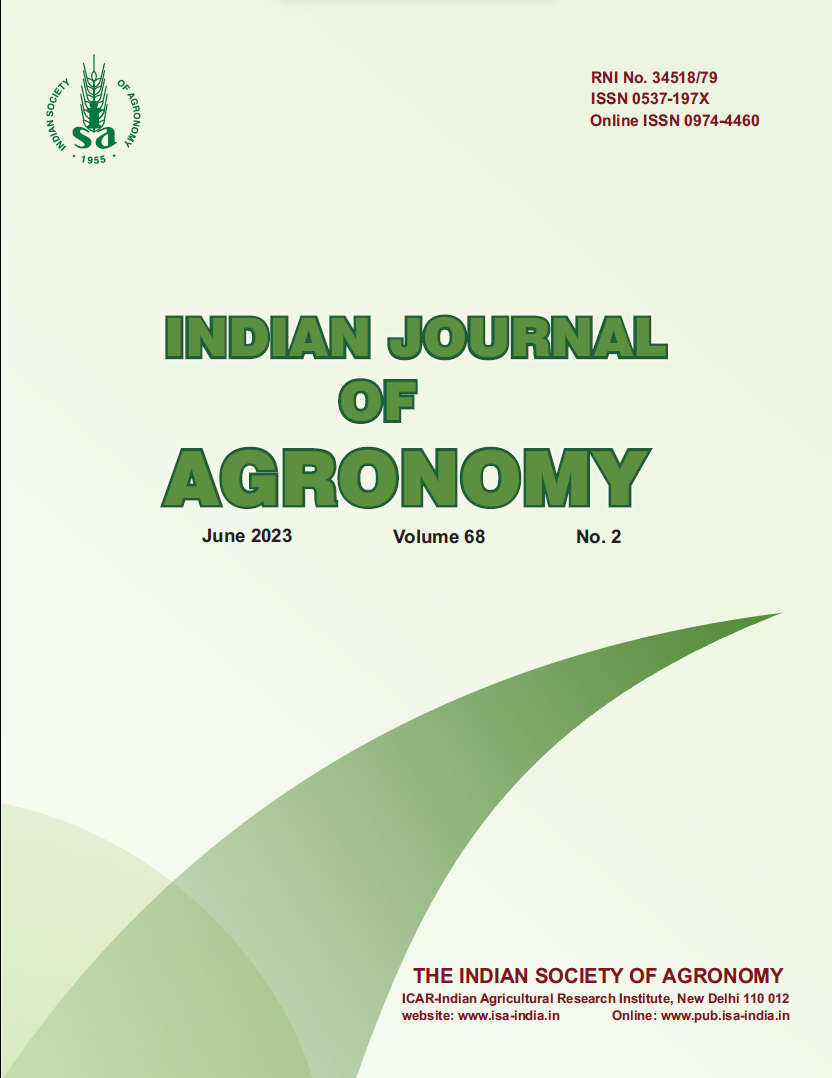Effect of irrigation schedules on productivity, quality and water use of Indian mustard (Brassica juncea) under staggered sowing in Northwest India
DOI:
https://doi.org/10.59797/ija.v68i2.355Keywords:
Indian mustard, Irrigation, Protein, Seed yield, Sowing date, Water-use efficiencyAbstract
A field experiment was conducted during the winter (rabi) seasons of 2019–20 and 2020–21 at the Guru Kashi University, Talwandi Sabo, Bathinda (Punjab), to study the effect of irrigation schedules on different growth, yieldattributing characters, yield, quality and water use in Indian mustard [Brassica juncea (L.) Czern.] in relation to sowing time. Results revealed that, early-sown crop, i.e. 10 October, recorded the higher growth parameters, viz. plant height, dry-matter accumulation, primary branches/plants, secondary branches/plant, and yield-attributing characters, viz. siliquae/plant, seeds/siliqua, siliqua length and 1,000-seed weight of Indian mustard. The crop sown on 10 October gave the highest seed yield (1449 kg/ha) which was significantly higher than the crop sown on 25 October (1,171 kg/ha) and 10 November (643 kg/ha). Oil yield, nitrogen content and protein content were also significantly higher in 10 October sown crop. Early-sown crop, i.e. 10 October, resulted in the 21.2 and 119.5% higher water-use efficiency (7.55 kg/ha/mm) than 25 October (6.23 kg/ha mm) and 10 November (3.44 kg/ha/mm) sown crop. Application of 3 irrigations, viz. at branching, flowering and siliqua-formation stages, resulted in higher plant height, dry matter, primary and secondary branches/plant, siliquae/plant, 1,000-seed weight, stover yield and harvest index in Indian mustard. Three irrigations at branching, flowering and siliqua-formation stages resulted in significantly higher seed yield (1,658 kg/ha), oil content (42.2%), oil yield (699.7 kg) and protein content (22.3%). This treatment resulted in the 23.3% higher water-use efficiency (6.50 kg/ha/mm) than the control (5.27 kg/ha/mm).
References
Akhter, S., Singh, L., Saxena, A., Lone, B.A., Singh, P. and Qayoom, S. 2014. Effect of temporal and varietal variability on growth and developmental parameters of brown sarson (Brassica rapa L. var. oleifera) under temperate Kashmir condition. Journal of AgriSearch 1: 122–126.
Amarasinghe, U., Bharat, R., Sharma, N.A., Christopher, S., Smakhtin, V., de-Fraiture, C., Sinha, A.K. and Shukla, A. 2004. Spatial variation in water supply and demand across river basins of India. IWMI Research Report 83, Colombo,
Sri Lanka.
AOAC. 1970. Official Methods of Analysis, edn 10. Association of Official Analytical Chemists, Washington, DC, USA.
Behboudian, M.H. and Singh, Z. 2002. Water relations and scheduling in grapevine. Horticultural Reviews 27: 189–225.
Dhillon, B.S. and Ram, H. 2020. Agroclimatic indices and yield of barley (Hordium vulgare) under different cutting management and sowing dates. Indian Journal of Agronomy 65 (2): 209–213.
Kadayifci, A. and Yildirim, O. 2000. The response of sunflower grain yield to water. Turkish Journal of Agriculture and Forestry 24: 137–145.
Kazi, B.R., Oad, F.C., Jamro, G.H., Jamali, L.A. and Oad, N.L. 2002. Effect of water stress on the growth, yield and oil content of sunflower. Pakistan Journal of Applied Sciences 2: 550–552.
Liu, H. and Kang, Y. 2006. Effect of sprinkler irrigation on microclimate in the winter wheat field in the north China Plain. Agricultural Water Management 84: 3–19.
Mandal, K.G, Hati, K.M., Misra, A.K. and Bandyopadhyay, K.K. 2006. Assessment of irrigation and nutrient effects on growth, yield and water use efficiency of Indian mustard (Brassica juncea) in central India. Agricultural Water Management 85: 279–286.
Michael, A.M. 2014. Sprinkler irrigation. (In): Irrigation Theory and Practice, edn 2, pp. 578–609. Vikas Publishing House, New Delhi, India.
Michael, A.M., Hukkeri, S.B. and Singh, N.P. 1977. Estimating water requirement and irrigation management of crops in India. Indian Council of Agricultural Research, Monograph No. 4, New Delhi. pp. 91–162.
PAU. 2020. Package of practices for rabi crops of Punjab. Punjab Agricultural University, Ludhiana. pp. 22–24.
Rafiei, T.S., Delkhosh, B., Rad, A.H.S. and Zandi, P. 2011. Effect of sowing dates and irrigation regimes on agronomic traits of Indian mustard in semi-arid area of Takestan. Journal of American Science 7: 721–728.
SAS. 2017. Version 9.4, SAS Institute, Inc Cary, NC, USA.
Singh, A.K., Singh, H., Rai, O.P., Singh, G., Singh, V.P., Singh, N.P. and Singh, R. 2017. Effect of sowing dates and varieties for higher productivity of Indian mustard (Brassica juncea L.). Journal of Applied and Natural Science 9 (2): 883–887.
Singh, A.K., Singh, R.R., Singh, A.K. and Singh, P.K. 2014. Influence of dates of sowing and irrigation scheduling on growth and yield of mustard (Brassica juncea L.). International Journal of Farm Sciences 4: 80–85.
Subbiah, B.V. and Asija, G.L. 1956. A rapid procedure for the estimation of available nitrogen in soils. Current Science 25: 259–260.
Thakral, S.K., Singh, B.P. and Faroda, A.S. 1997. Consumptive use, water use efficiency and soil moisture extraction patterns as influenced by irrigation levels, fertility levels and Brassica species. Indian Journal of Agricultural Research 31(1): 65– 70.






